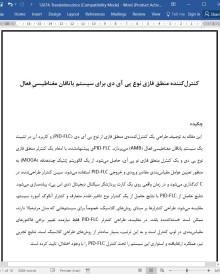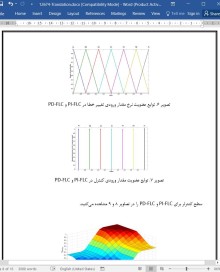
دانلود مقاله کنترل کننده منطق فازی نوع پی آی دی برای سیستم یاتاقان مغناطیسیی فعال
چکیده
این مقاله به توصیف طراحی یک کنترلکنندهی منطق فازی از نوع پی آی دی (PID-FLC) و کاربرد آن در تثبیت یک سیستم یاتاقان مغناطیسی فعال (AMB) میپردازد. PID-FLCی پیشنهادشده، با ادغام یک کنترلر منطق فازی نوع پی دی و یک کنترل منطق فازی نو پی آی، حاصل میشود. از یک الگوریتم ژنتیک چندهدفه (MOGA) به منظور تعیین عوامل مقیاسبندی مقادیر ورودی و خروجی PID-FLC استفاده میشود. سپس کنترلر طراحیشده، در C کدگذاری میشود و در زمان واقعی روی یک کارت پردازشگر سیگنال دیجیتال (دی اس پی)، پیادهسازی میشود. نتایج حاصل از PID-FLC با نتایج حاصل از یک کنترلر نوع تاخیر-تقدم متعارف و کنترلر آنالوگ آنبورد سیستم، مقایسه میشود. طراحی کنترلرها بر مبنای روشهای کلاسیک، خصوصاً برای سیستمهایی که مدل مرتبهبالا دارند، ممکن است خستهکننده باشد. در مقایسه، طراحی کنترلر PID-FLC فقط نیازمند تغییر برخی فاکتورهای مقیاسبندی در لوپ کنترل است و به این ترتیب، بسیار سادهتر از روشهای طراحی کلاسیک است. نتایج تجربی نیز، عملکرد ارتقایافته و استواری این سیستم را تحت کنترل PID-FLC را با وجود اختلال، تایید کرده است.
1. مقدمه
سیستمهای یاتاقان مغناطیسی فعال (AMB) میتوانند باعث تعلیق بدون تماس روتورها بواسطهی نیروهای الکترومغناطیسی جذابی شوند که الکترمغناطیسها تولید میکنند. یاتاقان مکانینی کلاسیک را میتوان با یاتاقانهای مغناطیسی فعال که نیروی جذب توسط جریان الکتریکی تامین میشود، جایگزین کرد. AMBها دارای مزیایا متعددی نسبت به یاتاقانهای مکانیکی و هیدرواستاتیک متعارف هستند. این مزایا عبارتند از فرسایس اصطکاکی صفر و عملکرد کارآمد در سرعت بسیار بالا. AMBها برای محیطهای تمیزی که نیازی به لغزندهکننده در آنها نیست، ایدهآل هستند. آنها میتوانند در محیطهای نامساعدی نظیر دمای بالا، بار سنگین و رطوبت بالا کار کنند. این مشخصات خاص، باعث شده توجه محققان در دهه گذشته، به آن جلب شود. از AMBها میتوان در کاربردهای صنعتی بسیاری استفاده کرد، یعنی جاهایی که عملکرد سریع و دقیق مورد نیاز است، نظیر فلایویلهای ذخیرهی انرژی، قلب مصنوعی، توربینهای سرعت بالا و موتورهای جت. اما مشخصات بسیار غیرخطی و بیثبات لوپباز این سیستمها، مانع از بکارگیری گستردهی تجاری و صنعتی AMBها شده است. از آنجا که AMB بیثبات است، شناسایی سیستم لوپبسته همیشه برای هدف طراحی کنترلر مبتنی بر مدل، لازم است. به منظور دستیابی به بهرهوری و عملکرد بالا که معمولاً از نظر سرعت بالا و زمان واکنش کوتاه در AMB است، لازم است AMB باثبات شود. هرچند که AMB مدت زیادی وجود داشته است، اما مسائل زیادی بر سیستمها حاکمند که باید مورد واکاوی قرار گیرند. برخی از این مسائل عبارتند از سختی متناهیِ یاتاقانها، عدم توازن روتور و نوسانهای فرکانس بالایی که بهراحتی ایجاد میشوند. بنابراین عملکرد سیستم کنترل AMBها، بهلحاظ ثبات و استواری باید بهبود یابد.
6. نتیجه
کنترلر PID-FLC با ادغام یک PI-FLC و یک PD-FLC طراحی شد. الگوریتم ژنتیک چندهدفه، بکار رفت تا از بدهبستان بین شاخصهای عملکرد متعارض چندگانهای نظیر خطای حالت ماندگار، فراجست، زمان نشست و زمان خیز، اطمینان حاصل شود. سپس کنترلر بهینهی PID-FLC، در زمان واقعی روی سیستم پیاده شد. نتایج آن با نتایج یک جبرانساز تقدم-تاخر متعارف و کنترلر آنالوگ آنبورد، با وجود اختلال، مقایسه شد. نتایج نشان میدهند که عملکرد این سیستم با استفاده از PID-FLC، در مقایسه با کنترلر آنالوگ آنبورد بهبود قابلملاحظهای یافته است. لازم به ذکر است که جبرانساز نوع تقدم-تاخر طراحیشده نیز عملکرد مطلوبی داشت. اما پیش از اینکه ثبات لوپبسته تحقق یابد، دو فیلتر شکاف و یک فیلتر پایینگذر باید به جبرانساز تقدم-تاخر طراحیشده، باید افزوده میشد. از سوی دیگر، PID-FLC با موفقیت و بدون نیاز به فیلتر شکاف و فیلتر پایینگذر، پیادهسازی شد.
Abstract
This paper describes the design of a PID-type Fuzzy Logic Controller (PID-FLC) and its application on the stabilization of an Active Magnetic Bearing System (AMB). The proposed PID-FLC is obtained by combining a PD-type Fuzzy Logic Controller (PD-FLC) and a PI-type Fuzzy Logic Controller (PI-FLC). A multi-objective Genetic Algorithm (MOGA) is used to determine the scaling factors of the inputs and outputs of the PID-FLC. The designed controller is then coded in C and implemented in real-time on a Digital Signal Processor (DSP) card. The results from the PID-FLC are compared with those of a conventional lead-lag type controller and the system’s on-board analogue controller. Designing controllers based on classical methods could become tedious, especially for systems with high order model. In contrast, PID-FLC controller design requires only the tuning of some scaling factors in the control loop and hence is much simpler than classical design methods. The experimental results have also verified the enhanced performance and robustness of the system under the proposed PID-FLC control in the presence of disturbance.
I. INTRODUCTION
Active Magnetic Bearing Systems (AMBs) can provide contactless suspension of rotors by attractive electromagnetic forces produced by electromagnets. Classical mechanical bearings can be replaced by active magnetic bearings, where the attraction force is provided by electric current. AMBs have various advantages over conventional mechanical and hydrostatic bearings. These advantages are zero frictional wear and efficient operation at extremely high speed. AMBs are ideal for clean environments where no lubrication is required. They can work in harsh environments such as high temperature, heavy load and high humidity. These special characteristics have attracted significant attention and interests amongst the researchers in the past decade. AMBs can be utilized in many industrial applications, where fast and precise operations are desired such as energy storage flywheels, artificial heart, high speed turbines and jet engines [1] and [2]. However, highly nonlinearity and open-loop unstable characteristics of these systems have hindered the widespread commercial and industrial application of AMBs. Since AMB is open-loop unstable, closed loop system identification is always required for model-based controller design purpose. In order to achieve high productivity and performance typically in terms of high speed and short response time in AMBs, it is necessary to have AMBs reliably stabilized. Even though the AMBs have existed for a long time, there are a lot of issues governing the systems that need to be explored. Some of these issues are finite bearing stiffness, rotor unbalance and easily excitable high frequency oscillations. Therefore, AMBs control system performance is demanding in terms of stability and robustness improvements.
VI. CONCLUSION
A PID-FLC controller was designed by combining a PIFLC and a PD-FLC. Multi-objective Genetic Algorithm (MOGA) was used to secure an optimal trade-off between multiple conflicting performance measures such as steady-state error, overshoot, settling time and rise time. The optimal PIDFLC controller was then implemented on the system in real time. The results were compared with those of a conventional lead-lag compensator and the on-board analogue controller in the presence of disturbance. The results show that the system’s performance was dramatically improved by using the PID-FLC compared to the on-board analogue controller. It is worth noting that the designed lead-lag type compensator also worked well. However, two notch filters and a low-pass filter had to be added to the designed lead-lag compensator before closed-loop stability becomes a reality. The PID-FLC, on the other hand, was successfully implemented without the need of any notch filters or low-pass filters.
چکیده
1. مقدمه
2. توصیف شناسایی مدل و سیستم
3. طراحی کنترلر فازی نوع پی آی دی
4. تنظیم فاکتورهای مقیاسبندی با استفاده از MOGA
5. پیادهسازی کنترلر فازی طراحیشده
6. نتیجه
منابع
Abstract
1. INTRODUCTION
2. DESCRIPTION OF THE MODEL AND SYSTEM IDENTIFICATION
3. PID-TYPE FUZZY CONTROLLER DESIGN
4. TUNING OF THE SCALING FACTORS USING MOGA
5. IMPLEMENTATION OF THE DESIGNED FUZZY CONTROLLER
6. CONCLUSION
REFERENCE
- اصل مقاله انگلیسی با فرمت ورد (word) با قابلیت ویرایش
- ترجمه فارسی مقاله با فرمت ورد (word) با قابلیت ویرایش، بدون آرم سایت ای ترجمه
- ترجمه فارسی مقاله با فرمت pdf، بدون آرم سایت ای ترجمه



